Ita Maximowna
Ita Maximowna | |
|---|---|
 Ita Maximowna c. 1950 | |
| Born | Margarita Maximowna Schnakenburg 18 October 1901 |
| Died | 8 April 1988 (aged 86) |
| Occupation |
|
| Awards | |
Ita Maximowna (born Margarita Maximowna Schnakenburg; 18 October [O.S. 31 October] 1901 – 8 April 1988)[1] was a Russian-German scenic designer, costume designer and illustrator. She was one of the first women in the professions in Germany who worked internationally. Trained as a painter, she came to the theatre late, after World War II in Berlin, and became a scenic designer first in theatres of the city, then internationally both for plays and opera, and in collaboration with directors such as a Günther Rennert and conductors such as Herbert von Karajan.
Life and career[]

Born Margarita Maximowna Schnakenburg in Pskov[2] in northwestern Russia, she was the daughter of dentists Elisabeth Natalie Ernestine Schnakenburg, née von Roth (1878–1966), and her husband Max Karl Heinrich Schnakenburg (1875–1919). Her older brother was Heinrich Ludwig Nicolai Schnakenburg. Her father died in 1919 of tuberculosis. Then, during the unrest after the 1917 October Revolution, the family fled to relatives in Davos, Switzerland.[2] In 1920, they moved to Germany, where her brother became an apprentice of 's Technikum für Buchdrucker in Leipzig, while she moved to Berlin with her mother.[3]
In 1920, she moved to Paris as a teacher of Russian.[3] There she met the graphic designer and stage designer Marie Laurencin, with whom she studied for several years.[2] From 1925, she studied further with the painter (1901–1940) and Johannes Boehland at the Akademie der Künste in Berlin.[2] In the early 1930s, she married Carl Fredrik Baumann, a former director of the company in Hamburg. She designed packaging of the company's products and advertising.[2] She also illustrated books.[3]
In 1945, she met her future partner[4] Karlheinz Martin, who was instrumental in reestablishing theatre in Berlin after the war. As general manager of the Hebbel Theatre, he opened the field of stage and costume design for her.[2][3] Under her shortened name, she worked for many years for the Hebbel Theater, , Schiller Theater and .[2][3] She was invited to the U.S. where she learned new techniques in three months, and returned to be a specialist for American plays.[1][3] She also worked internationally for opera houses in London, Paris, Milan, Vancouver, Buenos Aires and New York City. She collaborated with directors including O. E. Hasse, Karl-Heinz Stroux and especially Günther Rennert,[2] and conductors such as Leo Blech and Herbert von Karajan.[5] She often worked with her assistant and friend .[6]
In the 1960s and 1970s, she also created film sets,[7] such as Die Spieler and Die Nacht in Zaandam by Ludwig Berger, Der Revisor by Gustav Rudolf Sellner, and Die seltsamen Abenteuer des geheimen Kanzleisekretärs Tusmann by Helmut Käutner. At the end of her career, she turned to painting again.[2]

Ita Maximowna died on 8 April 1988 in Berlin.[2][8] She is buried with her partner in an honorary grave on the Friedhof Heerstraße in Berlin-Westend.[9]
Her artistic legacy is kept in the Ita-Maximowna-Archiv of the Archiv für Darstellende Kunst of the Akademie der Künste in Berlin.[2][10]
Awards[]
- Berliner Kunstpreis 1953[11] (for Die Zauberflöte)[4]
- Order of Merit of the Federal Republic of Germany, 5 March 1987, by Richard von Weizsäcker[1]:114[12]
Productions[]

Maximowna designed stage and costumes for around 400 productions of operas and plays.[4] Her first production was a double bill of Arthur Schnitzler's Grüner Kakadu and Franz Werfel's Kammersänger at the Berlin Renaissance Theatre in 1945.[1] In 1953, she designed Mozart's Die Zauberflöte for the Städtische Oper Berlin, directed by Rennert.[4] In 1955, she designed the work for Oper Frankfurt, conducted by Georg Solti.[13]
For the Vienna State Opera, she created sets for Salome by Richard Strauss (1957), Mozart's Le nozze di Figaro (1958), Rossini's La Cenerentola and Il turco in Italia, and Verdi's Un ballo in maschera (1982).[14] She designed the scene at the Salzburg Festival for Le nozze di Figaro from 1957, Die Zauberflöte from 1959, Ariadne auf Naxos by Richard Strauss from 1964, and Mozart's Così fan tutte from 1972, all directed by Rennert.[15] The 1972 production was conducted by Karl Böhm.[16]
In 1962, she made her debut at the Metropolitan Opera in New York City, designing Verdi's Un ballo in maschera, conducted by Nello Santi who also made his debut, with Leonie Rysanek and Carlo Bergonzi in the leading roles. A reviewer called her "one of the most sensitive and imaginative of contemporary designers".[17] The same year, she designed for Puccini's Der Mantel (Il tabarro) at the Staatstheater Stuttgart, conducted by Ferdinand Leitner.[18] In 1965, she designed for the world premiere of Klebe's Jacobowsky und der Oberst at the Hamburg State Opera.
Designs[]
Maximowna's designs have been described as "luftig-poetisch" (airy and poetic).[5]
Costume designs[]
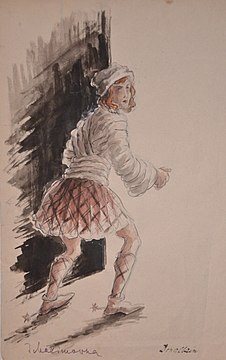
Donalbain, Macbeth, Hebbel Theater, Berlin (1945)
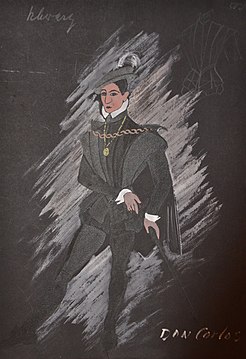
Don Carlos, opening Theater Bonn (1950)
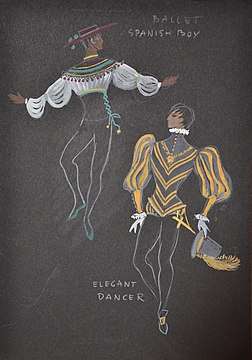
Don Giovanni, Teatro Colon (1963)
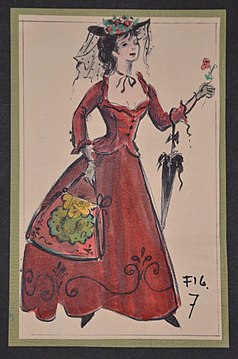
Georgette, Il tabarro, Bavarian State Opera (1973)
Stage sets[]
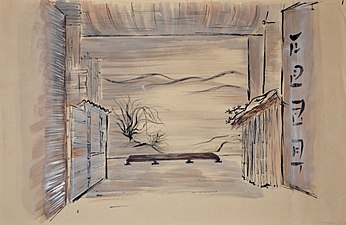
Das kleine Teehaus, Renaissance-Theater, Berlin (1954)
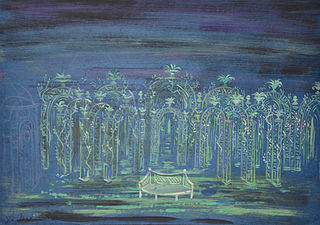
Le nozze di Figaro, Vienna State Opera (1958)
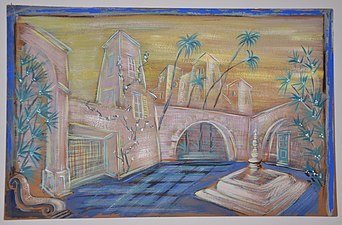
Der Barbier von Sevilla, Städtisches Opernhaus, Berlin (1957)
References[]
- ^ Jump up to: a b c d Behr, Bettina (2014). 3.3.1 Ita Maximovna (1914–1988). Bühnenbildnerinnen: Eine Geschlechterperspektive auf Geschichte und Praxis der Bühnenbildkunst (in German). transcipt Verlag. pp. 111–114. ISBN 978-3-83-942314-1.
- ^ Jump up to: a b c d e f g h i j k "Ita-Maximowna-Archiv" (in German). Akademie der Künste. Retrieved 28 September 2020.
- ^ Jump up to: a b c d e f Zemke, Andreas (1970). "1970: Interview mit Ita Maximowna". Deutsche Welle (in German). Retrieved 30 September 2020.
- ^ Jump up to: a b c d "Ita Maximowna / Painting / Galerie Mutare" (in German). artatberlin.com. 10 August 2018. Retrieved 3 November 2020.
- ^ Jump up to: a b "Gestorben / Ita Maximowna". Der Spiegel (in German). 18 April 1988. Retrieved 28 September 2020.
- ^ "Kurzbiographie Martin Rupprecht, Theater und Komödie am Kurfürstendamm". Wayback Machine (in German). 25 December 2013. Retrieved 23 September 2020.
- ^ "Ita Maximowna". filmportal.de (in German). Retrieved 23 September 2020.
- ^ Bühnenbildnerin Maximowna tot. Immer Dienst am Gesamtkunstwerk. In: Hamburger Abendblatt. 11 April 1988. p. 10. Retrieved 17 November 2019.
- ^ : Lexikon Berliner Begräbnisstätten. Pharus-Plan, Berlin 2018, ISBN 978-3-86514-206-1. S. 491. Franz Reichert: Durch meine Brille. Theater in bewegter Zeit (1925–1950). Österreichischer Bundesverlag, Wien 1986, ISBN 978-3-215-06062-5. p. 232.
- ^ Liste der Neuerwerbungen und Bestandserweiterungen 2009 Akademie der Künste Berlin, 14 January 2010
- ^ Darstellende Kunst (in German) Akademie der Künste
- ^ Bekanntgabe von Verleihungen des Verdienstordens der Bundesrepublik Deutschland. In: Bundesanzeiger. year 39, no. 146, p. 10553, 11 August 1987
- ^ Die Zauberflöte 1955
- ^ Vorstellungen mit Ita Maximowna Vienna State Opera
- ^ Opernproduktioen der Salzburger Festspiele (in German) austria-forum.org
- ^ Così fan tutte 2018, ISBN 978-0-71-454468-7
- ^ New production / Un Ballo in Maschera {75} Metropolitan Opera House: 01/25/1962. MET archives
- ^ Der Mantel (Giacomo Puccini) deutsche-digitale-bibliothek.de
Further reading[]
- Karla Höcker: Gespräche mit Berliner Künstlern. Stapp Verlag, Berlin 1964.
- Karla Höcker: Beschreibung eines Jahres. Berliner Notizen 1945. Arani Verlag, Berlin 1984. ISBN 3-7605-8577-9
External links[]
| Wikimedia Commons has media related to Ita Maximowna. |
- Literature by and about Ita Maximowna in the German National Library catalogue
- German scenic designers
- German costume designers
- German women illustrators
- Pseudonyms
- 1901 births
- 1988 deaths
- Officers Crosses of the Order of Merit of the Federal Republic of Germany






